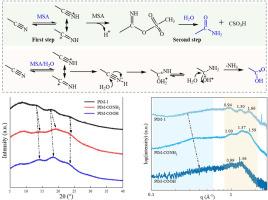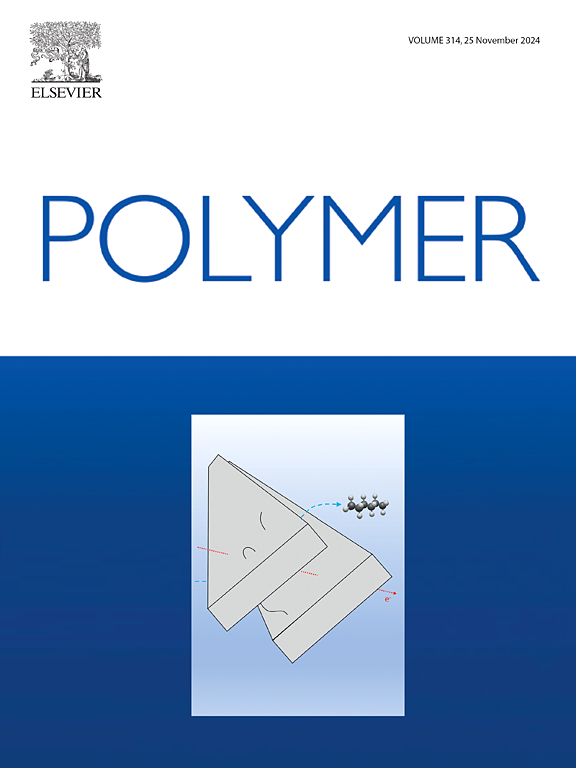In-depth understanding of the role of methanesulfonic acid in nitrile group conversion of PIM-1
IF 4.1
2区 化学
Q2 POLYMER SCIENCE
引用次数: 0
Abstract
Polymers of intrinsic microporosity (PIMs) exhibit unique structural properties, characterized by high surface area and rigid, twisted molecular configurations that hinder polymer chain stacking, resulting in micropores favorable for gas transport. PIM-1, a prominent member of this class, has been extensively explored for gas separation applications. However, its industrial use is limited by physical aging and low selectivity. To address these limitations, nitrile group functionalization in PIM-1, such as carboxyl group formation, has been investigated. In this study, we explore the hydrolysis of nitrile groups in PIM-1 under acidic conditions using pure methanesulfonic acid (MSA) and MSA/water mixtures. By systematically varying reaction parameters, we elucidate the transformation mechanism of nitriles to carboxylic acids. Results indicate that nitriles are effectively converted into the corresponding amides in pure MSA, while carboxylic acids (up to 80 %) in MSA/H2O mixtures. Characterization techniques, including FTIR, 1H NMR, UV–Vis spectroscopy, wide-angle X-ray diffraction (WAXD) and wide-angle X-ray scattering (WAXS), confirm the structural changes in the polymer and reveal contraction in interchain spacing due to hydrogen bonding. This study provides insights into optimizing the hydrolysis conditions for enhanced performance of PIM-based membranes in gas separation applications.


深入了解甲基磺酸在PIM-1腈基转化中的作用
固有微孔聚合物(PIMs)具有独特的结构特性,其特点是高表面积和刚性,扭曲的分子构型阻碍聚合物链堆叠,从而形成有利于气体输送的微孔。PIM-1是该类中的一个突出成员,已被广泛地用于气体分离应用。然而,它的工业应用受到物理老化和低选择性的限制。为了解决这些限制,研究了PIM-1中的腈基功能化,例如羧基的形成。在这项研究中,我们探索了在酸性条件下,使用纯甲基磺酸(MSA)和MSA/水混合物水解PIM-1中的腈基。通过系统地改变反应参数,阐明了腈转化为羧酸的机理。结果表明,在纯MSA中,腈类化合物可以有效地转化为相应的酰胺类化合物,而在MSA/水混合物中,羧酸类化合物的转化率高达80%。表征技术,包括FTIR、1H NMR、UV-Vis光谱、广角x射线衍射(WAXD)和广角x射线散射(WAXS),证实了聚合物的结构变化,并揭示了氢键导致的链间间距收缩。该研究为优化水解条件以增强pim基膜在气体分离应用中的性能提供了见解。
本文章由计算机程序翻译,如有差异,请以英文原文为准。
求助全文
约1分钟内获得全文
求助全文
来源期刊

Polymer
化学-高分子科学
CiteScore
7.90
自引率
8.70%
发文量
959
审稿时长
32 days
期刊介绍:
Polymer is an interdisciplinary journal dedicated to publishing innovative and significant advances in Polymer Physics, Chemistry and Technology. We welcome submissions on polymer hybrids, nanocomposites, characterisation and self-assembly. Polymer also publishes work on the technological application of polymers in energy and optoelectronics.
The main scope is covered but not limited to the following core areas:
Polymer Materials
Nanocomposites and hybrid nanomaterials
Polymer blends, films, fibres, networks and porous materials
Physical Characterization
Characterisation, modelling and simulation* of molecular and materials properties in bulk, solution, and thin films
Polymer Engineering
Advanced multiscale processing methods
Polymer Synthesis, Modification and Self-assembly
Including designer polymer architectures, mechanisms and kinetics, and supramolecular polymerization
Technological Applications
Polymers for energy generation and storage
Polymer membranes for separation technology
Polymers for opto- and microelectronics.
 求助内容:
求助内容: 应助结果提醒方式:
应助结果提醒方式:


